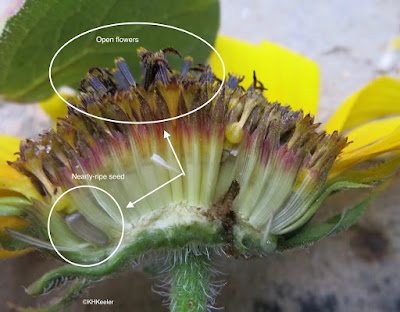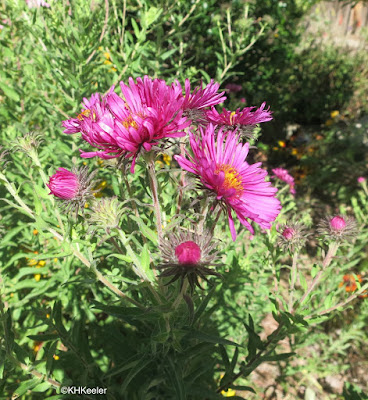| Rabbitbrush Ericameria nauseosa
Rabbitbrush Ericameria nauseosa is a shrub commonly known as Chamisa, rubber rabbitbrush, in areas of North America.
 |
| Rabbitbrush in August |
Who would have thought that late August would be too early for flowers?
And yet, I had that same experience in Lincoln, Nebraska with annual sunflowers. We wanted to do the first ecology laboratory of the fall semester as a comparison of how annuals and perennials allocate energy (annuals to flowers and seeds, perennials to roots), using sunflowers. When I went to locate plants in flower for the students to gather, the common sunflower, Helianthus annuus, had buds but no open flowers. That was the last week in August. Three weeks later we had all the common sunflowers we could use.
 |
| Wild common sunflowers, not quite flowering |
 |
| This aster's flowers are not available until late August |
Of course, projects once considered obscure become important as things change. Dave Inouye and colleagues at Rocky Mountain Biological Lab, Gothic, Colorado have been recording how many flowers are open in which species every other day during the growing season since 1974. Really. Sounds like something about which you'd've said "why on earth are you doing that?!!!"
But now, they have wonderful data that that show--not infer, show--that on the average, across 60 plant species, first flowering is 12 days earlier and peak flowering 10 days earlier than in the 1970s. (CaraDonna et al. 2014 link. ) As their environment changes, the plants respond.
Presumably seeds and fruit are ripening earlier too: for example, a report last week showed that the early ripening of red elderberries in 2014 in southern Alaska lured Kodiak bears away from salmon, leaving the fish to rot (link link).
 |
| red elderberries, Sambucus racemosa |
In the 1940s and 1950s, a series of important studies compared plants from low elevation (longer growing season) to high elevation, and from the southern U.S. (longer growing season) to the northern U.S., especially by growing them together in both places. Generally plants did much better in their native area.
It was easy to see why the lower elevation and southern plants failed in higher elevations or the north: the frost caught them before their seeds were ripe.
The reverse is subtler: why didn't higher elevation and northern plants survive well at lower elevations or in the south? Some of it may have been heat or drought stress, but there is another, less obvious difference. Lower elevation and southern plants have a longer growing season. They generally grow for more days, getting bigger and storing more energy, so that they produce more or bigger seeds. By getting bigger and producing more seeds than plants that stopped growing sooner, over a period of years they will out-compete their higher elevation or northern rivals.
Thinking about this can be mind-bending. Clearly there is a date that is too late to initiate flowering. For example, a plant that starts flowering in October, here at the base of the Rockies in Colorado, would likely have all its seeds killed by a hard frost. Waiting too long to flower can be disasterous.
You could work out the limits for each plant species. In particular, how many days are required for a seed to ripen after it is pollinated? Late-flowering plants have to ripen their seeds pretty quickly, so small seeds are good. Rabbitbrush seeds are small enough to be carried on the wind. Wild common sunflower seeds, however, although much smaller than commercial sunflower seeds, are still pretty big. But maybe they are insulated: the last florets (individual flowers) to bloom will be in the center of the seed head, perhaps that and their developing thick seed coat protect them from cold just a little longer.
 |
| Sunflower inflorescence (head) showing florets (flowers) at different stages |
Principles for wildflowers include: Grow as big as you can, but mature your seeds before frost.
But the seeds need not be synchronized, even within a single inflorescence.
A simple response of plants to a warming climate is for plants from lower elevations to move up in elevation and for southern plants to extend their ranges northward. But local plants will likely adapt too: as wildflowers that flower later into the fall mature more seeds than their neighbors, the next generation will include ever more late-flowering plants.
 |
| Rabbitbrush in flower |
 |
| An aster worth waiting for! |
References
CaraDonna, P. J., A. M. Iler and D. W. Inouye. 2014. Shifts in flowering phenology reshape a subalpine community. Proceedings of the National Academy of Sciences, U.S. A. 111 (13): 4916-4921. link
Clausen, J., D.D. Keck and . 1940. Experimental studies on the nature of species. I. Effects of varied environments on western North American plants. Publication 520. Carnegie Institute of Washington, Washington, D.C., USA.
Clausen, J., D. .D. Keck and W. M . Hiesey. 1948. Experimental studies on the nature of species. III: Environmental responses of climatic races of Achillea. Publication 581. Washington, D.C.: Carnegie Institution of Washington.
Deacy, W.W., W. A., J. B. Armstrong, W. B. Leacock, C. T. Robbins, C. D. Gustine, E. J.Ward, J.A.Erlenbach and J. A. Stanford.
2017.
Phenological synchronization disrupts trophic interactions between Kodiak brown bears and salmon. Proceedings of the National Academy of Sciences, U.S.A., published online Aug. 21, 2017, before print link
McMillan, C. 1965. Ecotypic variation within four North American prairie grasses: II. Behavioral variation within transplanted community fractions. American Journal of Botany. 52 (1): 55-65.
McMillan, C. 1969. Survival patterns of four prairie grasses transplanted to central Texas. American Journal of Botany. 56 (1): 105-115Yirka, B. 2017. Kodiak bears found to switch to eating elderberries instead of salmon as climate changes link (news report on Deacy et al. article).
Observe for yourself!
Or be guided by ideas in my recent book: NoCo Notables: 15 Northern Colorado Plants Worth Knowing Available at Amazon link
You might also like these blog posts:
Visiting China--Autumn greetings link

Marigolds from the Americas link

Flowers in January in Colorado link



No comments:
Post a Comment